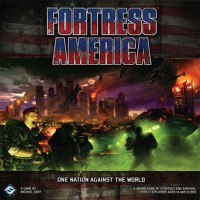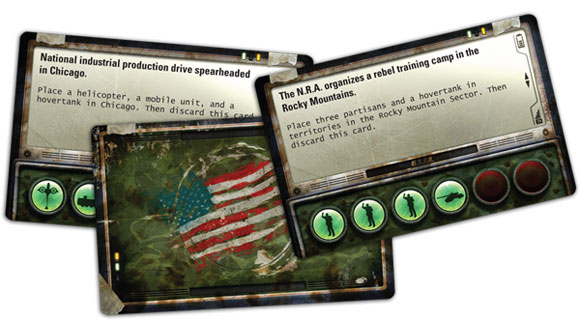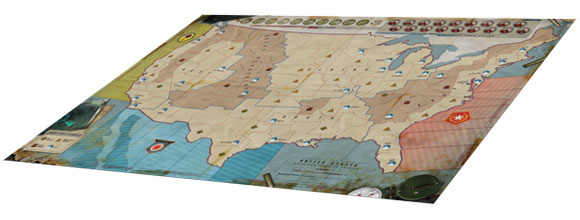
Fortress America

Fortress America is a board game of strategy and survival for two to four players. This updated version of the 1986 classic pits one player, in control of the beleaguered American forces, against up to three others, who team up to assault the U.S. on three fronts. Featuring beautifully crafted components (including over 300 detailed plastic figures), Fortress America thrusts players into a frightening geopolitical scenario in which diplomacy has failed, and World War III has begun.
In Fortress America, the United States must defend itself from three deadly invading armies: the Asian People’s Alliance from the West, the Central American Federation from the South, and the Euro-Socialist Pact from the East. Players take on either the role of the United States, struggling to protect itself from foreign threat, or the role of one or more of the invading armies, fighting battle after battle to acquire important territories.

If the invading forces claim enough U.S. cities, America’s defense is broken and the nation falls. But if the United States can protect its cities for long enough, the invading forces fail to uproot America and their incursion is ended.

Whether you’re a fan of the original or a newcomer to the game, Fortress America offers a fast-paced and desperate struggle for supremacy. The diplomatic options have been exhausted, and the fate of the world hangs in the balance.
User Reviews (4)
Add a Review for "Fortress America"
You must be logged in to add a review.


Overview
Fortress America was originally released in 1986 by Milton Bradley as apart of its Gamemaster Series. It then faded away to be brought back by Fantasy Flight Games in 2012.
Fortress America is about the US being invaded on three sides simultaneously by the Euro-Socialist Pact to the East, the Central American Federation from the South, and the Asian People’s Alliance from the West. In the original it was the US vs. Communists.
Its focus is on combined arms, which will be made prevalent after one play through.
It is a 2-4 player game that can last up to 4 hours.
Gameplay
Note: This is not to teach you how to play the game.
The game is one player playing as the United States vs. One to Three people playing as the invading forces. The Invaders go first followed by the US player.
Turn Order is as Follows:
-Reinforcements: Invaders place 8 units in their starting area and America places 1 Laser in a U.S. controlled city. America also plays 2 Partisan cards plus any bonus cards gained for recapturing a city.
-Declare Battles: The player chooses the territories they plan to attack.
-Maneuvers: Players move their units; in some instances this may be to position them for an invasion. Each unit has a set movement value.
-Fire Lasers: America fires its Lasers (Invaders do not take this action).
-Combat: Resolve all declared battles. The defender will roll dice first according the type of units they are defending with. It should be noted that destroyed units are removed from play immediately. This gives the defender an advantage by trying to eliminate invading units before they roll. Any invading units that remain then roll dice according the type of units they are defending with. Both sides only roll dice for their units one time, whether or not the invasion was a success.
-Invasion: Players can move their units again to secure a newly declared territory, to reinforce a weakened area, or to simply advance your forces.
-Supply Lines Check: Each Invading army must have a controlled supply line back to their starting area. Any unit cut off from supplies is destroyed and removed from the game.
-Capture Territories: Players take control of any territory they successfully claimed in the invasion phase. This is done by placing a corresponding control marker on the board.
The game uses three types of dice.
-Red(D6) used by Infantry and Mobile Infantry
-White(D8) used by Tanks and Helicopters
-Blue(D10) used by Bombers
Combined arms comes into play when you are trying to take a city or attacking a mountain region. There are two types of attack symbols, one in a circle and one not in a circle. The not in the circle does not count for attacking a city or in the mountains unless you are using combined arms (different types of units together).
The US player also gets to draw two Partisan Cards each turn and use them. These are basically one shot special powers/events. They also give the other type of unit the Partisan to the US player. They are quite nice and roll the white die if they are defending by themselves. Invaders can get cards in a variant listed in the rule book.
There are a lot of variants you can play to make it easier and harder for either side.
Components
As standard with pretty much every Fantasy Flight Game, these components are extremely nice. The map is a bit subdued to what it was in the first edition.
As always they should last a long time unless you are abusing the heck out of them. Also if you are worried about the cards, sleeves can be a nice thing if you want to do that.
Pros
-Fantastic Component Quality
-Has the theme, especially if you grew up in the cold war era.
-A nice Light leaning towards medium weight War Game.
-Rule book is pretty easy to understand and detailed without being complicated.
Cons
-Can be ruined by playing with an overbearing Alpha Gamer
-Tends to push the limit for game length at 4 hours, but is still fun
-Some choices can seem overwhelming at first.
Conclusion/Thoughts
Its the same as the first edition with minor changes. There are people out there who say that the game is unbalanced/lopsided. Some say US is more powerful and vice versa. Honestly the US is weaker in a 2 player game but stronger in a 4 player game. This is due to the number of people playing the invaders not getting along well in their strategy. Yes talking to each other is good, but don’t let it all become lets just crush this guy talks. The variants add some nice replay value.
Its still fun with hardly any mechanic changes in nearly 3 decades since its release. I have played it with a wide variety of people from those getting into boardgaming all the way to hardcore war gamers. They have all had enjoyment from it. .
I own this game and have played three times now. Twice as the US and once as all the other invading forces. This game seems simple but is super difficult in my opinion to be the US. Both times I got my *** handed to me and as the invading forces I slaughtered the US. The reason why I like this game is the same reason why gamblers continue to us slot machines the “near miss effect.” As the US player there is always some glimmer of hope that seems as though you could win and I still think it’s possible and why I’ll keep trying.
The mechanics are interesting with helicopters scouting abilities to cut off enemy retreat. Then the ability to make bombing runs. The custom dice are fun and rules are hard to get through because Fantasy Flight is repetitive to the point of confusion sometimes. Overall it’s a fun hack and slash throw dice game if that’s your thing. My group of gamers however made a good point about the game. How can air units defend?
This game was great when it came out back in the 80’s, and it is still fun today. An epitome of Ameritrash in all its glory! The new version has different minis, but they are as cool or cooler than the originals. The square box has a more efficient footprint. This was one of the first board games I owned as a kid and I am still proud to have it as an adult.
Components 5/5
Rules 4/5
Gameplay 5/5
Player Interaction 5/5
Pretty colors.
Pretty pieces.
Go America!
Too short….
“Oh, say can you see by the dawn’s early light
What so proudly we hailed at the twilight’s last gleaming?
Whose broad stripes and bright stars thru the perilous fight,
O’er the ramparts we watched were so gallantly streaming?
And the rocket’s red glare, the bombs bursting in air,
Gave proof through the night that our flag was still there.
Oh, say does that star-spangled banner yet wave
O’er the land of the free and the home of the brave?”
“On the shore, dimly seen through the mists of the deep,
Where the foe’s haughty host in dread silence reposes,
What is that which the breeze, o’er the towering steep,
As it fitfully blows, half conceals, half discloses?
Now it catches the gleam of the morning’s first beam,
In full glory reflected now shines in the stream:
‘Tis the star-spangled banner! Oh long may it wave
O’er the land of the free and the home of the brave!”
“And where is that band who so vauntingly swore
That the havoc of war and the battle’s confusion,
A home and a country should leave us no more!
Their blood has washed out their foul footsteps’ pollution.
No refuge could save the hireling and slave
From the terror of flight, or the gloom of the grave:
And the star-spangled banner in triumph doth wave
O’er the land of the free and the home of the brave!”
“Oh! thus be it ever, when freemen shall stand
Between their loved home and the war’s desolation!
Blest with victory and peace, may the heav’n rescued land
Praise the Power that hath made and preserved us a nation.
Then conquer we must, when our cause it is just,
And this be our motto: “In God is our trust.”
And the star-spangled banner in triumph shall wave
O’er the land of the free and the home of the brave!”